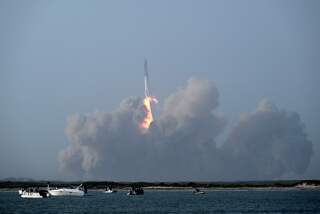NASA contracts with SpaceX and Boeing for space transport
- Share via
The United States took its first major step to returning to manned space flight as NASA awarded up to $6.8 billion to aerospace giant Boeing and California-based SpaceX to launch astronauts into space.
In a throwback to the golden age of space flight, the contracts call for Apollo-like capsules that would ferry astronauts to the International Space Station. The space agency chose not to return to the winged space shuttle design, electing instead to build vehicles that would be lifted into space atop a rocket, travel to the space station, and then splash down in the ocean.
The contracts — one to an aerospace stalwart and another to an upstart — also reflect new realities of funding space missions: They must be affordable.
NASA, which has preferred in the past to own and operate spacecrafts, will now rely on commercial vehicles that it will essentially rent.
“Turning over low-Earth orbit transportation to private industry will also allow NASA to focus on an even more ambitious mission — sending humans to Mars,” NASA Administrator Charles Bolden said Tuesday at a news conference at Kennedy Space Center in Florida.
The contracts return Southern California, once the epicenter for Apollo and space shuttle development, to a prime role in space flight.
It was a major announcement for NASA, but even bigger for SpaceX and its founder, Elon Musk.
The company is only 11 years old, with more than 3,000 employees, most building rockets, engines and the Dragon spacecraft at its Hawthorne factory. SpaceX, short for Space Exploration Technologies Corp., had already won a NASA contract to ferry cargo to the space station.
But this is another mark in Musk’s favor as he lobbies to level the playing field of governmental space contracts, which have long been dominated by Boeing, Lockheed and other aerospace powerhouses.
For Boeing, hundreds of employees in Huntington Beach and El Segundo will be involved in designing and testing the spacecraft it has proposed to NASA, said John Mulholland, vice president of the company’s commercial programs for space exploration.
Chicago-based Boeing recently moved the headquarters for its Network and Space Systems to El Segundo from Washington, D.C. It plans to build the new spacecraft, known as the CST-100, at its facility at the Kennedy Space Center.
By awarding the contracts to two companies, NASA could end up with two operating spacecraft that can fly astronauts to orbit. It also sets up an immediate competition between the companies to show which vehicle is better and more cost-effective.
It could also prove Musk’s theory that space travel doesn’t need to be so expensive.
For the same work, SpaceX said it needed $2.6 billion from NASA; Boeing requested and received $4.2 billion.
“SpaceX does things less expensively,” said Marco Caceres, senior space analyst at the Teal Group in Fairfax, Va. “They are a younger company with lower overhead. They want to continue to develop the commercial space industry and be the leader.”
To decrease costs, SpaceX, for example, hopes its spacecraft will eventually touch down safely on land, not splash into the ocean, making more of its equipment reusable.
But Caceres said NASA had also made a safe choice by including Boeing, which has built nearly every manned spacecraft in U.S. history.
“If astronauts were to die” on a craft built by SpaceX or one of the other start-up companies that had competed for the contract, Caceres said, “there would be a lot of second guessing.”
After two disasters and 30 years of service, NASA’s space shuttles were retired in 2011. It is now paying the Russian government about $70 million a seat to transport U.S. astronauts to the space station. That arrangement, which was always intended to be temporary, has become strained in recent months amid tension between Russia and Ukraine.
“Today we are one step closer to launching our astronauts from U.S. soil on American spacecraft and ending the nation’s sole reliance on Russia by 2017,” NASA Administrator Bolden said.
But by selecting Boeing, NASA will not end its dependence on Russia. Boeing’s spacecraft will launch with a rocket engine known as the RD-180, which is manufactured in Russia.
“There is an irony here,” Caceres said. “We’re trying to decrease reliance on Russia,” but by choosing Boeing, “we’re basically back to square one.”
Boeing’s Mulholland said the company used the launch system that includes the Russian engine because it was “the most reliable launch vehicle in its class.”
He said the company had other options if the Russian engines became unavailable.
Under the new contract, the companies will own and operate the spacecraft, which NASA called “crew transportation systems.” The companies can also sell space flights to private customers.
Both companies must pass multiple tests to prove they can safely put astronauts into orbit. The companies must perform a test flight to the space station with a NASA astronaut by 2017.
Each company will conduct at least two missions to the space station.
“Boeing has been part of every American human space flight program, and we’re honored that NASA has chosen us to continue that legacy,” said John Elbon, vice president of Boeing’s space exploration division.
Musk said in a statement that SpaceX was “deeply honored by the trust NASA has placed in us.”
“It is a vital step in a journey that will ultimately take us to the stars and make humanity a multi-planet species,” he said.
It has been a good month for Musk. Nevada announced that it was offering another company Musk founded, the electric carmaker Tesla, economic incentives valued at more than $1 billion to build a battery factory that promises to create 6,500 jobs in the state.
Twitter: @melodypetersen
More to Read
Inside the business of entertainment
The Wide Shot brings you news, analysis and insights on everything from streaming wars to production — and what it all means for the future.
You may occasionally receive promotional content from the Los Angeles Times.











